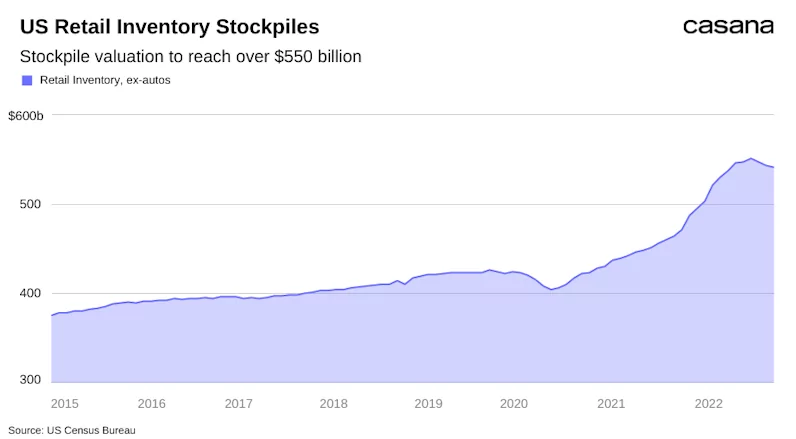An organization’s ability to prepare for supply chain fluctuations presents a unique opportunity to turn industry instability into a significant competitive advantage. Casana’s Supply Chain and Production Manager, Shannon Clements, took a look at how it’s possible to predict the unpredictable during the pandemic; over a year later the situation has almost turned on its head. So how does this affect consumers, and what should they expect in the coming months? Casana has a few predictions.
What is the supply chain?
To put it simply, supply chain refers to the sequence of processes involved in the production and distribution of a commodity. The optimization of these systems includes how raw materials make it to their destination and become components of products distributed all over the world.
Supply chains make up the foundation of most, if not all, businesses today. Managing the complex logistics systems that keep businesses running as smoothly as possible ensures that even with changing consumer demands—and supply chain disruptions brought about by the COVID-19 pandemic—products will arrive on time and up to the standards of the consumers and businesses involved.
What affects supply chains?
A variety of factors can affect supply chains due to their complex and interconnected nature. From existing or new geopolitical conflicts to inflationary pressures and the recessionary environment, understanding the far-reaching effects these influences may have on a supply chain is crucial. When faced with unexpected challenges it’s up to supply chain managers to predict how all of these elements can impact access to goods, how they flow to their final destination, create port holdups, reduce container and ocean freight availability, and surge prices, among other concerns.
What does this mean for consumers?
These overarching supply chain trends affect each industry differently. For example, apparel and housewares retailers, in fear of long delays and shortages, ordered more production than they needed. The lead time caused a massive inventory overstock, resulting in a surplus that led to the disposal of products en masse through strategies like utilizing resale websites, hosting sample sales, offering deep discounts, and even throwing goods away.

Other companies have been impacted by longer wait times, especially those who rely heavily on technological goods like Casana.
The Heart Seat supply chain
Chips, caps, and many of the specialized components in the Heart Seat™ still have extended lead times, meaning Casana has to plan further in advance to ensure on-time delivery. This increased planning can be a challenge for many reasons, including but not limited to:
Cost Fluctuations: “Although we are seeing lead times and costs start to return to what they were pre-pandemic—there was a time period when lead times were really high, and prices had gone up because of this,” says Clements.”We’re definitely not back to pre-pandemic levels in some regards.”
Ordering for Years Ahead: “Raw components for printed circuit boards still have extended lead times, so we’re faced with the challenge of having to really monitor and understand the factors that affect our ability to get to a place where we know we have the materials that we need,” says Clements. “Some parts that we require have a lead time of over seventy-seven weeks!”
Evolving Demand for Finished Products: Clements adds, “I think we’re in a unique situation because The Heart Seat™ is still in development. It’s a very different situation for companies that have finalized products and predictable needs, but due to the fast-paced nature of our company, we have a lot more we have to consider. Ensuring that Casana can remain agile despite these challenges is only possible through thorough supply chain management.”
What to expect in the future.
Until consumers regain confidence in purchasing despite the burden of high inflation costs, it’s unlikely businesses will be able to dump their excess inventory anytime soon. This surplus has led to a sharp slowdown in global trade growth and thus stagnating manufacturing activity.
Consumers can expect retail brands to reduce their overabundance of inventory through increased promotions and sales, although this process will likely take years to accomplish. The imbalance between supply and demand will continue to have a substantial effect on product development, manufacturing, and supply chain until consumers renew their purchasing power.
Despite supply chain turbulence, Casana is pleased to announce an expected product launch at the end of 2023. Email info@casanacare.com for more information or sign up for updates from Casana to stay in the know on product and company announcements
Recommended insights
Nontraditional Electrocardiogram and Algorithms for Inconspicuous In-Home Monitoring: Comparative Study
Casana has been devoted to the study and development of effortless, noninvasive, in-home monitoring since our very conception. The feasibility of Casana’s first product, The Heart Seat, has been tested in a number of studies, one...Read More
Toilet Talk: The Heart Seat is Not Just Another Gadget
A Casana engineer on why working on The Heart Seat is an engineer’s dream.
